Marketing Report: Internationalization and Market Entry Mode Analysis
VerifiedAdded on 2021/04/19
|7
|1705
|109
Report
AI Summary
This report provides a critical analysis of "Internationalization and Market Entry Mode: A Review of Theories and Conceptual Frameworks." It explores various aspects of foreign entry mode decisions, examining conceptual frameworks through the lens of the research article. The report delves into theoretical and methodological aspects, including entry mode as a chain of establishment, the transaction cost approach, the eclectic framework, and the organizational capability perspective. Each mode is analyzed, discussing its strengths, weaknesses, and the behavioral assumptions underpinning it, such as bounded rationality and opportunism. The report highlights the interconnectedness of these concepts, emphasizing the importance of integrating resource-based theory and considering factors like ownership, location, and internalization advantages. The conclusion stresses the importance of a well-established internalization and market entry mode.
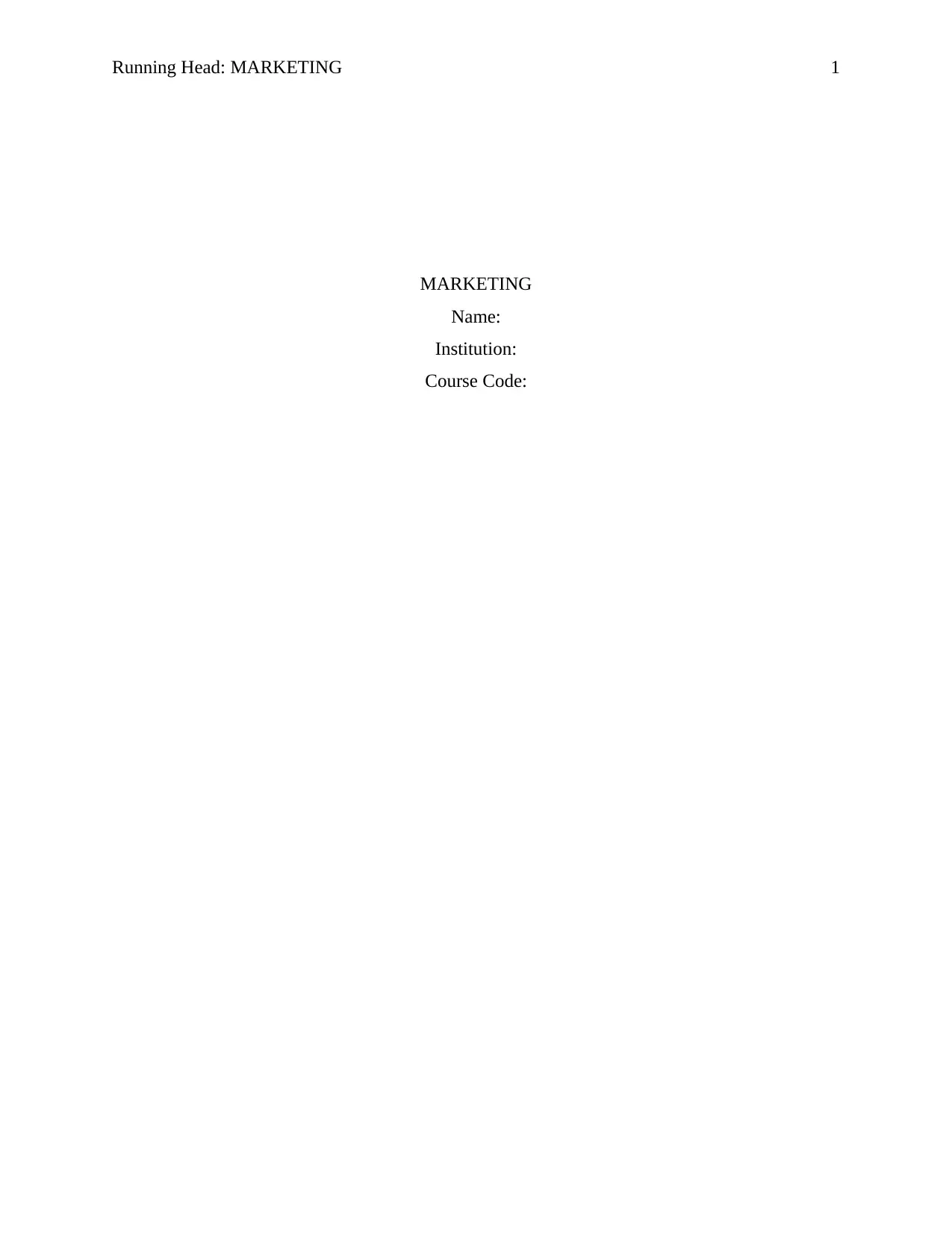
Running Head: MARKETING 1
MARKETING
Name:
Institution:
Course Code:
MARKETING
Name:
Institution:
Course Code:
Paraphrase This Document
Need a fresh take? Get an instant paraphrase of this document with our AI Paraphraser
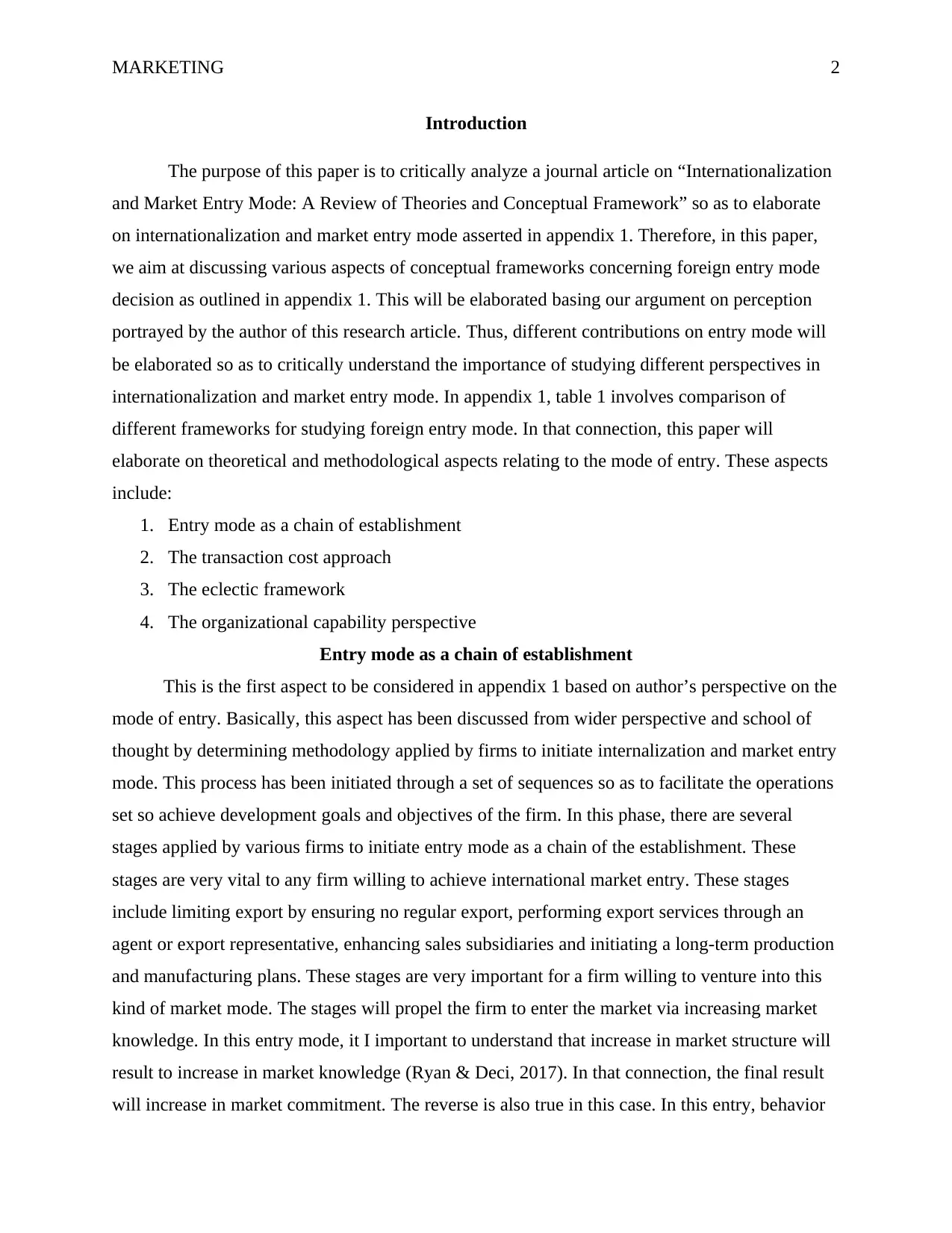
MARKETING 2
Introduction
The purpose of this paper is to critically analyze a journal article on “Internationalization
and Market Entry Mode: A Review of Theories and Conceptual Framework” so as to elaborate
on internationalization and market entry mode asserted in appendix 1. Therefore, in this paper,
we aim at discussing various aspects of conceptual frameworks concerning foreign entry mode
decision as outlined in appendix 1. This will be elaborated basing our argument on perception
portrayed by the author of this research article. Thus, different contributions on entry mode will
be elaborated so as to critically understand the importance of studying different perspectives in
internationalization and market entry mode. In appendix 1, table 1 involves comparison of
different frameworks for studying foreign entry mode. In that connection, this paper will
elaborate on theoretical and methodological aspects relating to the mode of entry. These aspects
include:
1. Entry mode as a chain of establishment
2. The transaction cost approach
3. The eclectic framework
4. The organizational capability perspective
Entry mode as a chain of establishment
This is the first aspect to be considered in appendix 1 based on author’s perspective on the
mode of entry. Basically, this aspect has been discussed from wider perspective and school of
thought by determining methodology applied by firms to initiate internalization and market entry
mode. This process has been initiated through a set of sequences so as to facilitate the operations
set so achieve development goals and objectives of the firm. In this phase, there are several
stages applied by various firms to initiate entry mode as a chain of the establishment. These
stages are very vital to any firm willing to achieve international market entry. These stages
include limiting export by ensuring no regular export, performing export services through an
agent or export representative, enhancing sales subsidiaries and initiating a long-term production
and manufacturing plans. These stages are very important for a firm willing to venture into this
kind of market mode. The stages will propel the firm to enter the market via increasing market
knowledge. In this entry mode, it I important to understand that increase in market structure will
result to increase in market knowledge (Ryan & Deci, 2017). In that connection, the final result
will increase in market commitment. The reverse is also true in this case. In this entry, behavior
Introduction
The purpose of this paper is to critically analyze a journal article on “Internationalization
and Market Entry Mode: A Review of Theories and Conceptual Framework” so as to elaborate
on internationalization and market entry mode asserted in appendix 1. Therefore, in this paper,
we aim at discussing various aspects of conceptual frameworks concerning foreign entry mode
decision as outlined in appendix 1. This will be elaborated basing our argument on perception
portrayed by the author of this research article. Thus, different contributions on entry mode will
be elaborated so as to critically understand the importance of studying different perspectives in
internationalization and market entry mode. In appendix 1, table 1 involves comparison of
different frameworks for studying foreign entry mode. In that connection, this paper will
elaborate on theoretical and methodological aspects relating to the mode of entry. These aspects
include:
1. Entry mode as a chain of establishment
2. The transaction cost approach
3. The eclectic framework
4. The organizational capability perspective
Entry mode as a chain of establishment
This is the first aspect to be considered in appendix 1 based on author’s perspective on the
mode of entry. Basically, this aspect has been discussed from wider perspective and school of
thought by determining methodology applied by firms to initiate internalization and market entry
mode. This process has been initiated through a set of sequences so as to facilitate the operations
set so achieve development goals and objectives of the firm. In this phase, there are several
stages applied by various firms to initiate entry mode as a chain of the establishment. These
stages are very vital to any firm willing to achieve international market entry. These stages
include limiting export by ensuring no regular export, performing export services through an
agent or export representative, enhancing sales subsidiaries and initiating a long-term production
and manufacturing plans. These stages are very important for a firm willing to venture into this
kind of market mode. The stages will propel the firm to enter the market via increasing market
knowledge. In this entry mode, it I important to understand that increase in market structure will
result to increase in market knowledge (Ryan & Deci, 2017). In that connection, the final result
will increase in market commitment. The reverse is also true in this case. In this entry, behavior
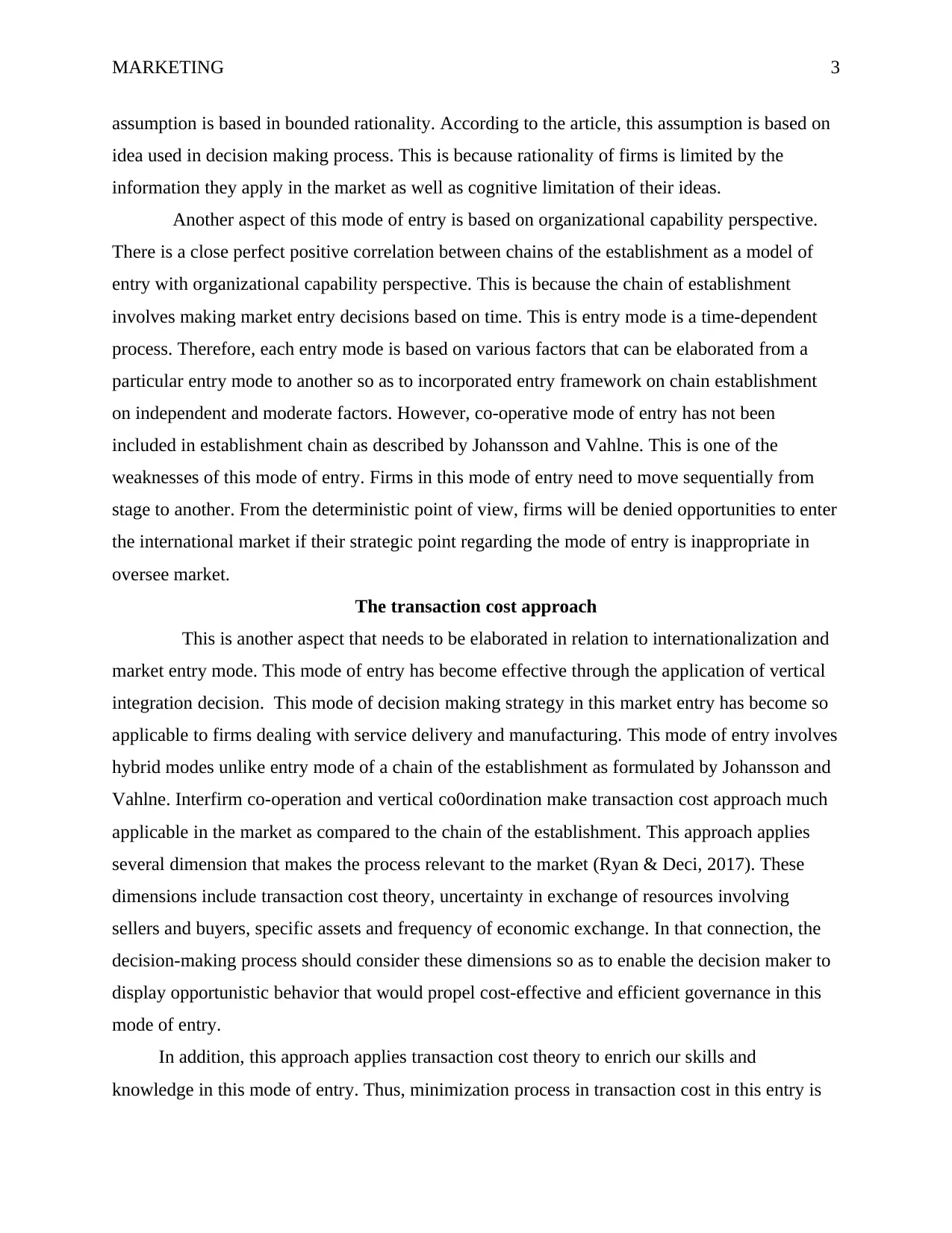
MARKETING 3
assumption is based in bounded rationality. According to the article, this assumption is based on
idea used in decision making process. This is because rationality of firms is limited by the
information they apply in the market as well as cognitive limitation of their ideas.
Another aspect of this mode of entry is based on organizational capability perspective.
There is a close perfect positive correlation between chains of the establishment as a model of
entry with organizational capability perspective. This is because the chain of establishment
involves making market entry decisions based on time. This is entry mode is a time-dependent
process. Therefore, each entry mode is based on various factors that can be elaborated from a
particular entry mode to another so as to incorporated entry framework on chain establishment
on independent and moderate factors. However, co-operative mode of entry has not been
included in establishment chain as described by Johansson and Vahlne. This is one of the
weaknesses of this mode of entry. Firms in this mode of entry need to move sequentially from
stage to another. From the deterministic point of view, firms will be denied opportunities to enter
the international market if their strategic point regarding the mode of entry is inappropriate in
oversee market.
The transaction cost approach
This is another aspect that needs to be elaborated in relation to internationalization and
market entry mode. This mode of entry has become effective through the application of vertical
integration decision. This mode of decision making strategy in this market entry has become so
applicable to firms dealing with service delivery and manufacturing. This mode of entry involves
hybrid modes unlike entry mode of a chain of the establishment as formulated by Johansson and
Vahlne. Interfirm co-operation and vertical co0ordination make transaction cost approach much
applicable in the market as compared to the chain of the establishment. This approach applies
several dimension that makes the process relevant to the market (Ryan & Deci, 2017). These
dimensions include transaction cost theory, uncertainty in exchange of resources involving
sellers and buyers, specific assets and frequency of economic exchange. In that connection, the
decision-making process should consider these dimensions so as to enable the decision maker to
display opportunistic behavior that would propel cost-effective and efficient governance in this
mode of entry.
In addition, this approach applies transaction cost theory to enrich our skills and
knowledge in this mode of entry. Thus, minimization process in transaction cost in this entry is
assumption is based in bounded rationality. According to the article, this assumption is based on
idea used in decision making process. This is because rationality of firms is limited by the
information they apply in the market as well as cognitive limitation of their ideas.
Another aspect of this mode of entry is based on organizational capability perspective.
There is a close perfect positive correlation between chains of the establishment as a model of
entry with organizational capability perspective. This is because the chain of establishment
involves making market entry decisions based on time. This is entry mode is a time-dependent
process. Therefore, each entry mode is based on various factors that can be elaborated from a
particular entry mode to another so as to incorporated entry framework on chain establishment
on independent and moderate factors. However, co-operative mode of entry has not been
included in establishment chain as described by Johansson and Vahlne. This is one of the
weaknesses of this mode of entry. Firms in this mode of entry need to move sequentially from
stage to another. From the deterministic point of view, firms will be denied opportunities to enter
the international market if their strategic point regarding the mode of entry is inappropriate in
oversee market.
The transaction cost approach
This is another aspect that needs to be elaborated in relation to internationalization and
market entry mode. This mode of entry has become effective through the application of vertical
integration decision. This mode of decision making strategy in this market entry has become so
applicable to firms dealing with service delivery and manufacturing. This mode of entry involves
hybrid modes unlike entry mode of a chain of the establishment as formulated by Johansson and
Vahlne. Interfirm co-operation and vertical co0ordination make transaction cost approach much
applicable in the market as compared to the chain of the establishment. This approach applies
several dimension that makes the process relevant to the market (Ryan & Deci, 2017). These
dimensions include transaction cost theory, uncertainty in exchange of resources involving
sellers and buyers, specific assets and frequency of economic exchange. In that connection, the
decision-making process should consider these dimensions so as to enable the decision maker to
display opportunistic behavior that would propel cost-effective and efficient governance in this
mode of entry.
In addition, this approach applies transaction cost theory to enrich our skills and
knowledge in this mode of entry. Thus, minimization process in transaction cost in this entry is
⊘ This is a preview!⊘
Do you want full access?
Subscribe today to unlock all pages.

Trusted by 1+ million students worldwide
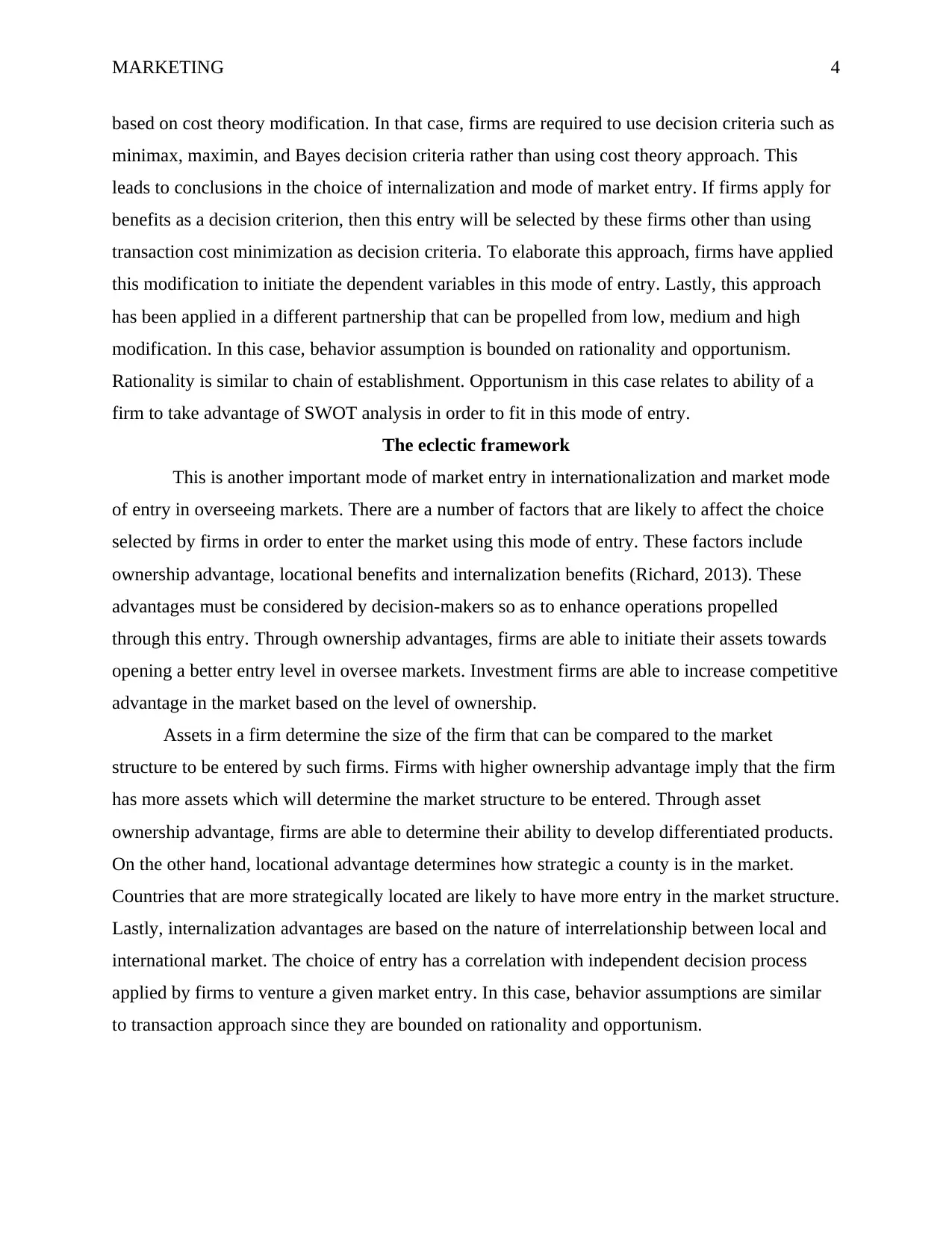
MARKETING 4
based on cost theory modification. In that case, firms are required to use decision criteria such as
minimax, maximin, and Bayes decision criteria rather than using cost theory approach. This
leads to conclusions in the choice of internalization and mode of market entry. If firms apply for
benefits as a decision criterion, then this entry will be selected by these firms other than using
transaction cost minimization as decision criteria. To elaborate this approach, firms have applied
this modification to initiate the dependent variables in this mode of entry. Lastly, this approach
has been applied in a different partnership that can be propelled from low, medium and high
modification. In this case, behavior assumption is bounded on rationality and opportunism.
Rationality is similar to chain of establishment. Opportunism in this case relates to ability of a
firm to take advantage of SWOT analysis in order to fit in this mode of entry.
The eclectic framework
This is another important mode of market entry in internationalization and market mode
of entry in overseeing markets. There are a number of factors that are likely to affect the choice
selected by firms in order to enter the market using this mode of entry. These factors include
ownership advantage, locational benefits and internalization benefits (Richard, 2013). These
advantages must be considered by decision-makers so as to enhance operations propelled
through this entry. Through ownership advantages, firms are able to initiate their assets towards
opening a better entry level in oversee markets. Investment firms are able to increase competitive
advantage in the market based on the level of ownership.
Assets in a firm determine the size of the firm that can be compared to the market
structure to be entered by such firms. Firms with higher ownership advantage imply that the firm
has more assets which will determine the market structure to be entered. Through asset
ownership advantage, firms are able to determine their ability to develop differentiated products.
On the other hand, locational advantage determines how strategic a county is in the market.
Countries that are more strategically located are likely to have more entry in the market structure.
Lastly, internalization advantages are based on the nature of interrelationship between local and
international market. The choice of entry has a correlation with independent decision process
applied by firms to venture a given market entry. In this case, behavior assumptions are similar
to transaction approach since they are bounded on rationality and opportunism.
based on cost theory modification. In that case, firms are required to use decision criteria such as
minimax, maximin, and Bayes decision criteria rather than using cost theory approach. This
leads to conclusions in the choice of internalization and mode of market entry. If firms apply for
benefits as a decision criterion, then this entry will be selected by these firms other than using
transaction cost minimization as decision criteria. To elaborate this approach, firms have applied
this modification to initiate the dependent variables in this mode of entry. Lastly, this approach
has been applied in a different partnership that can be propelled from low, medium and high
modification. In this case, behavior assumption is bounded on rationality and opportunism.
Rationality is similar to chain of establishment. Opportunism in this case relates to ability of a
firm to take advantage of SWOT analysis in order to fit in this mode of entry.
The eclectic framework
This is another important mode of market entry in internationalization and market mode
of entry in overseeing markets. There are a number of factors that are likely to affect the choice
selected by firms in order to enter the market using this mode of entry. These factors include
ownership advantage, locational benefits and internalization benefits (Richard, 2013). These
advantages must be considered by decision-makers so as to enhance operations propelled
through this entry. Through ownership advantages, firms are able to initiate their assets towards
opening a better entry level in oversee markets. Investment firms are able to increase competitive
advantage in the market based on the level of ownership.
Assets in a firm determine the size of the firm that can be compared to the market
structure to be entered by such firms. Firms with higher ownership advantage imply that the firm
has more assets which will determine the market structure to be entered. Through asset
ownership advantage, firms are able to determine their ability to develop differentiated products.
On the other hand, locational advantage determines how strategic a county is in the market.
Countries that are more strategically located are likely to have more entry in the market structure.
Lastly, internalization advantages are based on the nature of interrelationship between local and
international market. The choice of entry has a correlation with independent decision process
applied by firms to venture a given market entry. In this case, behavior assumptions are similar
to transaction approach since they are bounded on rationality and opportunism.
Paraphrase This Document
Need a fresh take? Get an instant paraphrase of this document with our AI Paraphraser
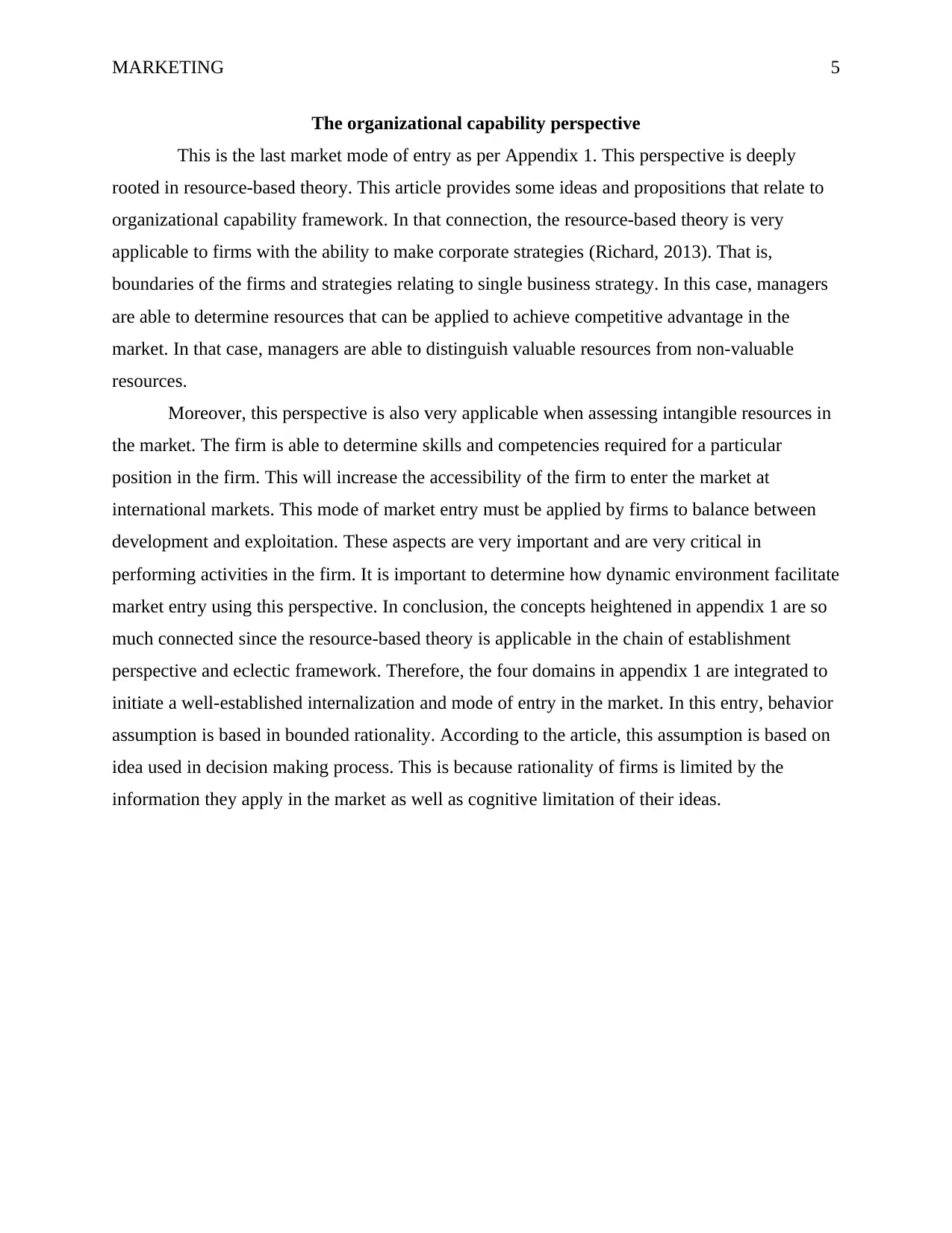
MARKETING 5
The organizational capability perspective
This is the last market mode of entry as per Appendix 1. This perspective is deeply
rooted in resource-based theory. This article provides some ideas and propositions that relate to
organizational capability framework. In that connection, the resource-based theory is very
applicable to firms with the ability to make corporate strategies (Richard, 2013). That is,
boundaries of the firms and strategies relating to single business strategy. In this case, managers
are able to determine resources that can be applied to achieve competitive advantage in the
market. In that case, managers are able to distinguish valuable resources from non-valuable
resources.
Moreover, this perspective is also very applicable when assessing intangible resources in
the market. The firm is able to determine skills and competencies required for a particular
position in the firm. This will increase the accessibility of the firm to enter the market at
international markets. This mode of market entry must be applied by firms to balance between
development and exploitation. These aspects are very important and are very critical in
performing activities in the firm. It is important to determine how dynamic environment facilitate
market entry using this perspective. In conclusion, the concepts heightened in appendix 1 are so
much connected since the resource-based theory is applicable in the chain of establishment
perspective and eclectic framework. Therefore, the four domains in appendix 1 are integrated to
initiate a well-established internalization and mode of entry in the market. In this entry, behavior
assumption is based in bounded rationality. According to the article, this assumption is based on
idea used in decision making process. This is because rationality of firms is limited by the
information they apply in the market as well as cognitive limitation of their ideas.
The organizational capability perspective
This is the last market mode of entry as per Appendix 1. This perspective is deeply
rooted in resource-based theory. This article provides some ideas and propositions that relate to
organizational capability framework. In that connection, the resource-based theory is very
applicable to firms with the ability to make corporate strategies (Richard, 2013). That is,
boundaries of the firms and strategies relating to single business strategy. In this case, managers
are able to determine resources that can be applied to achieve competitive advantage in the
market. In that case, managers are able to distinguish valuable resources from non-valuable
resources.
Moreover, this perspective is also very applicable when assessing intangible resources in
the market. The firm is able to determine skills and competencies required for a particular
position in the firm. This will increase the accessibility of the firm to enter the market at
international markets. This mode of market entry must be applied by firms to balance between
development and exploitation. These aspects are very important and are very critical in
performing activities in the firm. It is important to determine how dynamic environment facilitate
market entry using this perspective. In conclusion, the concepts heightened in appendix 1 are so
much connected since the resource-based theory is applicable in the chain of establishment
perspective and eclectic framework. Therefore, the four domains in appendix 1 are integrated to
initiate a well-established internalization and mode of entry in the market. In this entry, behavior
assumption is based in bounded rationality. According to the article, this assumption is based on
idea used in decision making process. This is because rationality of firms is limited by the
information they apply in the market as well as cognitive limitation of their ideas.
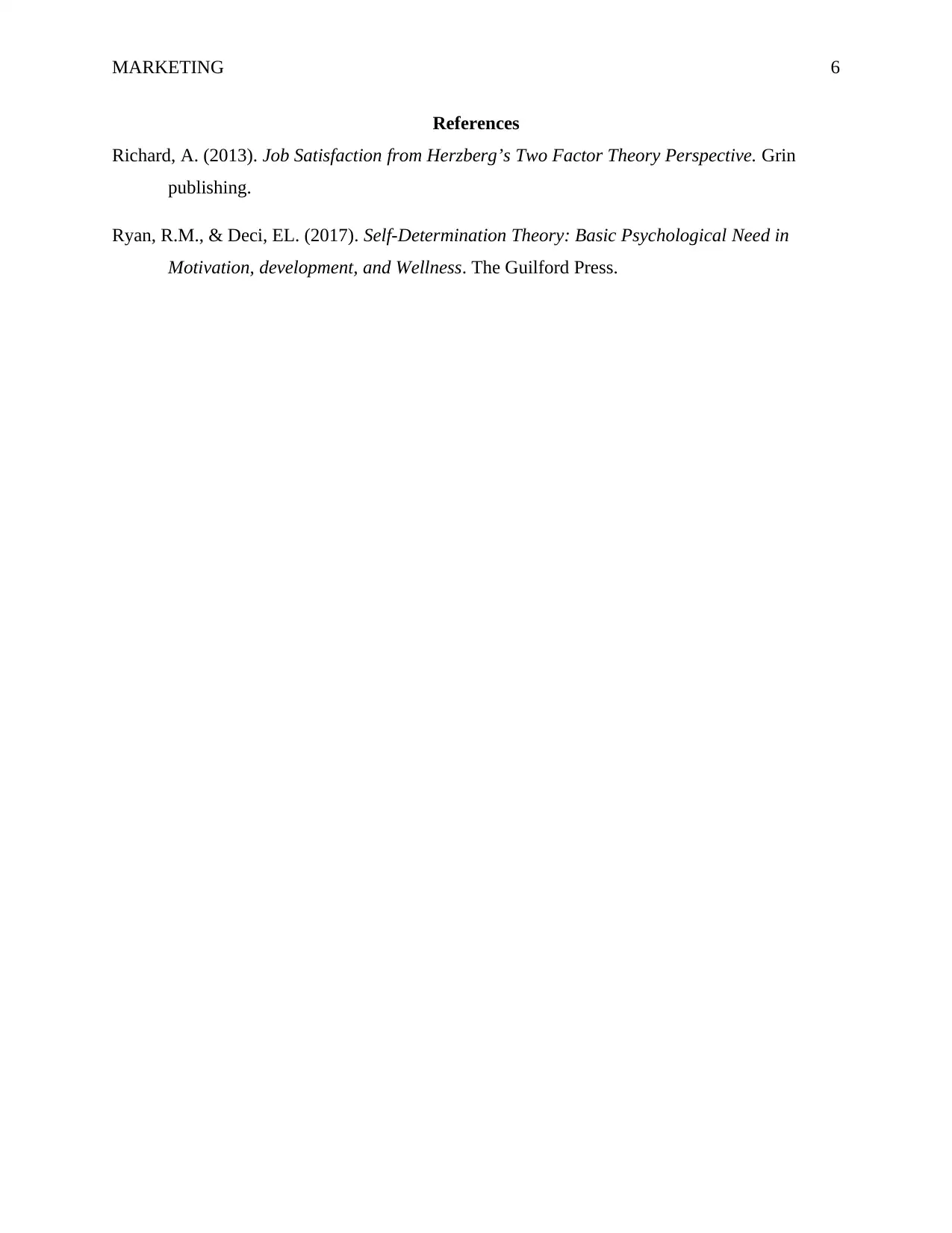
MARKETING 6
References
Richard, A. (2013). Job Satisfaction from Herzberg’s Two Factor Theory Perspective. Grin
publishing.
Ryan, R.M., & Deci, EL. (2017). Self-Determination Theory: Basic Psychological Need in
Motivation, development, and Wellness. The Guilford Press.
References
Richard, A. (2013). Job Satisfaction from Herzberg’s Two Factor Theory Perspective. Grin
publishing.
Ryan, R.M., & Deci, EL. (2017). Self-Determination Theory: Basic Psychological Need in
Motivation, development, and Wellness. The Guilford Press.
⊘ This is a preview!⊘
Do you want full access?
Subscribe today to unlock all pages.

Trusted by 1+ million students worldwide
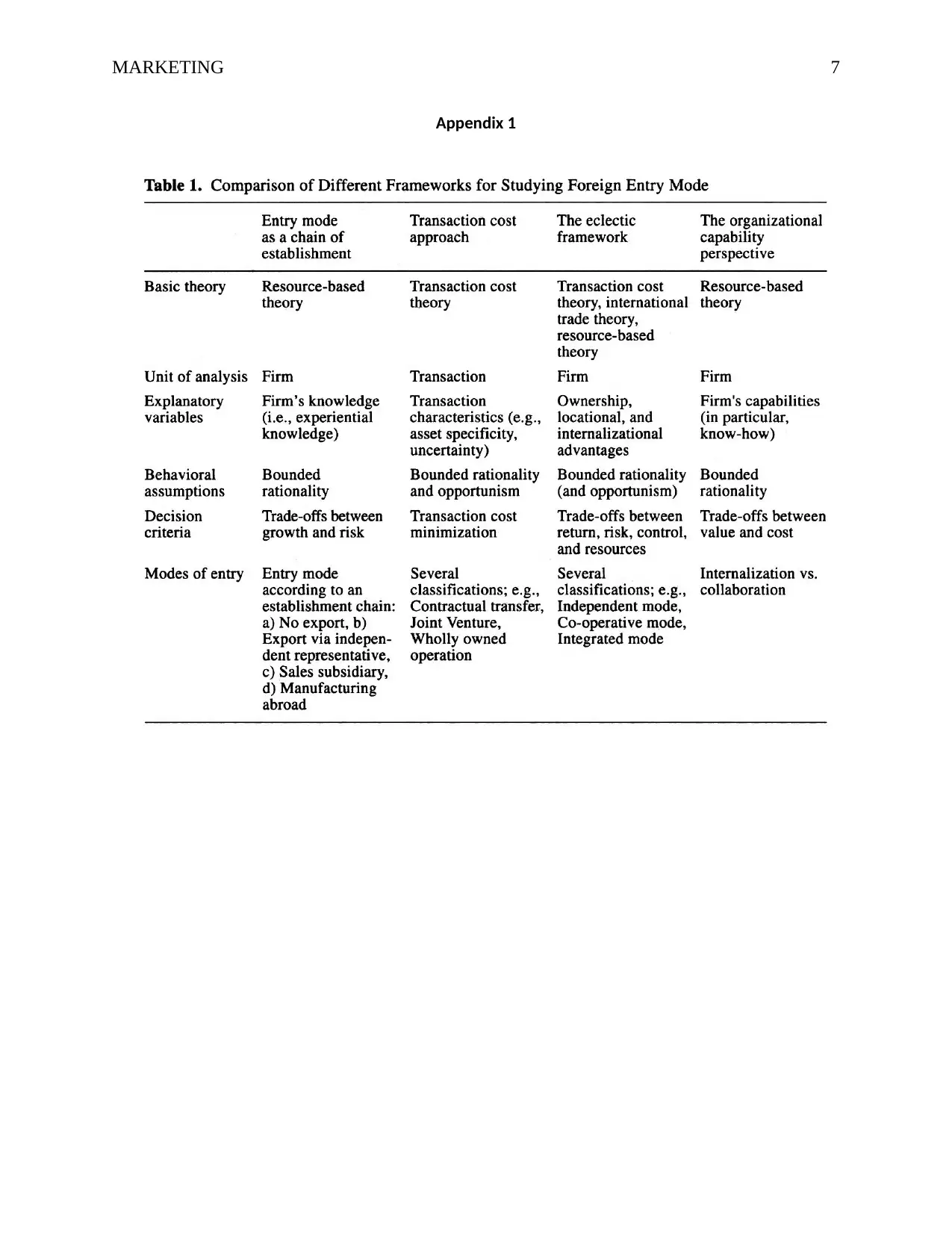
MARKETING 7
Appendix 1
Appendix 1
1 out of 7
Your All-in-One AI-Powered Toolkit for Academic Success.
+13062052269
info@desklib.com
Available 24*7 on WhatsApp / Email
![[object Object]](/_next/static/media/star-bottom.7253800d.svg)
Unlock your academic potential
Copyright © 2020–2025 A2Z Services. All Rights Reserved. Developed and managed by ZUCOL.
